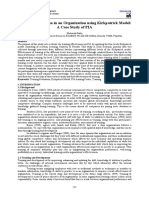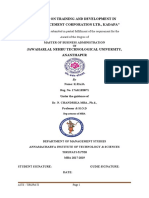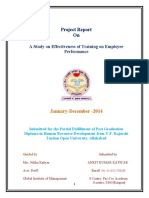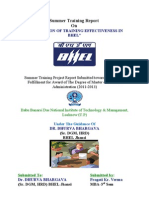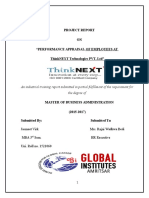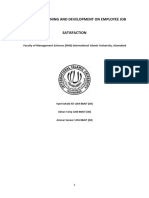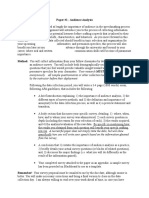A STUDY ON
TRAINING AND DEVELOPMENT
IN
VESTAS WIND TECHNOLOGY
PRIVATE LIMITED, CRENNAI
CONTENTS
Chapter No. Title Page No.
I Conceptual framework 06-16
II Methodology 17-19
III Organization Profile 20-45
IV Data Analysis and 46-61
Interpretation
V Findings, Suggestions 62-67
and Conclusion
Bibliography 68
Annexure 69-73
CHAPTER-I
CONCEPTUAL FRAMEWORK
TRAINING AND DEVELOPMENT
Employee Training is distinct from management or Executive Development. While the
former refers, training is given to employees in areas of operations, techniques and allied
areas, while the latter refers to developing an employee in areas of important techniques of
the Management Administration, Organization and allied areas.
Training means to continuously nurture the employees or workers towards better
performance in a systematic way. This can be either at the work spot or at the workshops. This
is mainly to improve the technical skills of the employees or workers.
Development means bringing out the actual potentialities and thus willing to high
motivation and commitment standards towards work. This will be generally with regard to
improvement in the behavioral skills.
CONCEPT OF TRAINING
I NTRODUCTI ON
Every organization needs to have well-trained and experienced people to perform the
activities that have to be done. So, every modem Management has to develop Human
Resources Development. In a rapidly changing society, employee training is not only an
activity that an organization must arrange if it is to maintain a viable and knowledgeable
workforce. Training is thus a practical and vital necessity.
MEANING
Training is the process of increasing the knowledge and skill of an employee for doing a
particular job. Training is short-term educational process and utilizing a systematic and
organized procedure by which employees learn knowledge and skills for a definite
purpose. Training improves, moulds, changes the employee's knowledge, skills,
behavior, aptitude and attitude towards the requirement of the job and organization.
OBJECTIVES OF TRAINING
Training is mainly job-oriented.
To impart the basic knowledge and skill to the new entrants and enable them to
perform their jobs well.
4,4, To teach the employees the new techniques and ways of performing the jobs and
operations.
To prepare the employees for higher level task and build up a second line of
competent officers.
NEED FOR TRAINING
Training is considered as a key input for developing manpower in an organization so as to
improve their job performance.
The need for training arises on account of the following reasons:
To match the employee specifications with the job requirements and
organizational needs.
Org,nizational viability and transformation process.
Latest technological advances should be adopted i.e., mechanization,
computerization and automation.
Internal mobility from one job to another due to promotion and transfer to
employees.
IMPORTANCE OF TRAINING
Training is an important process of imparting knowledge to the employees. It helps in
improving productive and behavioral pattern. Training is advantageous not only to the
organization but also to the employees. Training is vital and necessary activity in all
organizations. It plays a large part in determining the effectiveness and efficiency of the
establishment.
- DALE.S.BEACH
BENEFITS OF TRAINING PROGRAMME
A well-planned and executed Training Programme can provide the following
developments:
Higher productivity and profitability.
Better quality of work and best work methods. )=-
Less wastage of time during the learning period.
Improves high morale among the employees
> Personal growth of individuals. >
Low accident rates.
> Improves employer employee relations.
PRINCIPLES OF TRAINING
The principles, which have been evolved, can be followed as guidelines to trainees. Clear
objectives about the Training Programme are:
Training policy for designing and implementing the training programme.
Acquisition of knowledge and new skills through motivation.
Reinforcement to trainees by means of awards and punishments.
Organized material should be properly prepared and provided to the trainees.
Learning periods has to be fixed as it takes time to learn.
Preparing he instructor who is both good at subject and job.
Feedback regarding the performance of the trainees in the jobs.
Practicing the skills taught by the trainee.
Appropriate techniques related to the needs and objectives of the organization.
METHODS OF TRAINING
Training is essential for the smooth economic timely and efficient service of the
organization.
Training methods or techniques represents the medium of imparting skills and knowledge to
the employees.
There are two methods of training:
1. On-the-job training methods
2. Off-the-job training methods
ON THE JOB TRAINING
This method is also called as "Internal Training Method". This is suitable for all levels of
employees workers, supervisors and executives.
In this method, the employee gets training on the job and at the work place it self the
trainee learns while he/she is actually engaged in doing a job. This method is called as
"learning by doing".
Several methods are used to provide on-the-job training. They are
Job rotation
Coaching
Job instruction
Committee assignments
OFF THE JOB TRAINING
This method is also called as "External Training Methods". These methods are designed and
intended to impart training by supplying required knowledge and skill to the
employees away from the job and work place. This is an opportunity for freedom of
expression for the trainees.
Several methods are used to provide off-the-job training. They are:
Vestibule training
Role playing
Lecture method
Conference or Group Discussion method
Programmed instruction
TYPES OF TRAINING
Training is required for several purposes. Accordingly, training programme may be of the
following types:
Orientation training o
Job training
o Safety training
o Promotional training
o Refresher training o
Remedial training o
Individual training o
Team training
Business training o
Executive training
ASSESSMENT OF TRAINING NEEDS
Training activities must be related to the specific needs of the organization and the
individual employees. A Training Programme should be launched only after the training
needs are assessed clearly and specifically.
The effectiveness of a Training Programme can be judged only with the help of training
needs identified in advance. In order to identify the training needs, a gap between the
existing and required levels of knowledge, skills, performance and aptitudes should be
specific. The problem areas that can be resolved through training should also be
identified.
Training needs can be identified through the following types of analysis:
Organizational Analysis
Task or Role Analysis
Job Analysis
Man Analysis
Training programme, training methods and course content are to be planned on the basis of
training needs. Training needs are those aspects necessary to perform the job in the
organization in which employee lacks aptitude/attitude, knowledge and skill.
The following methods are used to assess the Training Needs:
i. Organizational requirements/weaknesses
ii. Departmental requirements/weaknesses
iii. Job specification and Employee specification
iv. Identifying the specific problems
v. Anticipating the future problems
vi. Management's request
vii. Observation
viii, Interviews
ix. Group Conferences
x. Questionnaire surveys
xi. Test
xii. Check lists
xiii. Performance appraisal time
These are essential when technical are special information of complex nature is to be
imparted. The lectures are supplemented with discussion film, case studies and
roleplaying
DESIGNING A TRAINING PROGRAMME
In order to achieve the training objectives, an appropriate Training Policy is necessary. A
training policy represents the commitment of top management to employee training. It
consists of rules and procedures concerning training.
A Training Policy is required:
a, To indicate the company's intention to develop its employees.
b. To guide the design and implementation of the Training Programmes,
c. To identify the critical areas where training is to be given on priority basis.
d. To provide appropriate opportunities to employees for their own betterment.
EVALUATION OF THE TRAINING PROGRAMME
The effectiveness of an investment in training in needed to be appraised as so much of
money is invested in a Training Programme. Management needs to be reassured about the
effectiveness of a particular method, instruction, the relation between training cost,
proved productivity, general efficiency and effectiveness of a course.
CONCEPT OF EXECUTIVE DEVELOPMENT
INTRODUCTION
Executives are the most valuable assets of any organization. The manager or executive is the
dynamic life-giving element in an organization. The success and growth of an
organization depends largely on the caliber and performance of its executives. Therefore,
systematic and continues efforts are necessary to prepare executives who can successfully
meet the challenges of the present and future.
MEANING
`Executive Development' is also called as Management Development.
It is a systematic approach of learning and growth by which managerial personnel gain and
apply knowledge, skills, attitudes and insights to manage the work in their
organizations effectively and efficiently. Executives learn conceptual knowledge,
theoretical knowledge and managerial skills in an organized manner. It is largely self
development.
OBJECTIVES OF EXECUTIVE DEVELOPMENT
The Management Development programmes are organized with a view to achieving
specific objectives. They are:
To improve the performance of managers at all levels in their present jobs.
To prepare managers for the higher jobs in future.
To provide opportunities to executives to fulfill their career aspirations.
To understand the problems of human relations and improve human relations
skill.
To stimulate creative thinking.
NEED OR IMPORTANCE OF EXECUTIVE DEVELOPMENT
Executive Development is the programme by which executive's capacities to achieve
desired objectives are achieved. No organization can be successful in the long run
without a planned approach to the development of its managerial persons. The following
factors emphasize the need for Executive Development programmes:
Growth and size of the organizations.
Technological and social changes.
Recognition of social and public responsibilities.
Growth of International Business.
Re-awakening of ethical and moral values.
PRINCIPLES OF EXECUTIVE DEVELOPMENT
The Top Management should accept responsibility for getting the policy of
executive development.
Executive Development programmes must be geared to the needs of the company
and the individuals.
Executive Development starts with the selection of the right man for the executive
positions.
A realistic timetable or time schedule for the development of executives should be
prepared keeping in view the present and future needs of the organization.
Learner's participation is essential for development. It brings significant growth.
Feedback should be made available to the learner so that steps can be taken to
improve.
An organizational climate conductive to executive development should be
created.
TECHNIQUES OF EXECUTIVE DEVELOPMENT
There are mainly two types of techniques by which managers can acquire the knowledge,
skills and attitudes, which make themselves competent managers. They are:
1. On-the-job development techniques
2. Off-the-job development techniques
ON THE JOB DEVELOPMENT
In these techniques, the motivation to learn is high as training takes place in the real job
situation. The important techniques are:
Coaching
Understudy
Position rotation
Project assignment
Committee assignment
Selective readings
OFF THE JOB DEVELOPMENT
In these techniques, the executives have to learn in their work place or office and devote
their entire time to the development objective. The important techniques are:
Case study method
Incident method
Role playing
Group discussions
Management games
Sensitivity training
Simulation method
Conference method
Lecture method
CHAPTER-11
METHODOLOGY
RESEARCH DESIGN
Data collected for the study has been divided into two parts.
PRIMARY DATA
This data will be mainly gathered through various questionnaires being distributed by
interacting with officials at different levels
SECONDARY DATA
This data will be collected through computer based reports from the published sources like
books and periodicals and reports like Annual Training Reports as well as from
VESTAS website.
SAMPLING TECHNIQUE
The data can also be obtained by applying sampling technique on the following segments in
the areas of Training & Development mentioned below:
Training needs
Types of Training
Effects of Training of employees
Implementation of Training techniques into work procedures
SEGMENTS
Workmen
Employees
o Technical
o Non-technical
Executives
o Floor level
o Middle level
o Top level
LIMITATIONS OF THE STUDY
Time is the big constraint
Cooperation from employees is less
Employees were not willing to fill questionnaire
SCHEME OF PRESENTATION:
The entire study is presented in 5 chapters:
Chapter-I deals with CONCEPTUAL FRAME WORK
Chapter-I1 gives a picture about the METHODOLOGY of the study.
PROFILE OF THE ORGANIZATION is presented in chapter-III
vi DATA ANALYSIS & INTERPRETATION of the study is presented in chapter-
ry
Chapter-V deals with FINDINGS, SUGGESTIONS AND CONCLUSIONS of
the study.
CHAPTER - III
ORGANIZATION PROFILE
This chapter gives detailed information about the Industry Profile Wind Industry,
Organizational Profile Vestas Wind Technology Private Limited and Performance
Management System in Vestas Organization
INDUSTRY PROFILE WIND INDUSTRY
Introduction
Wind power is produced by the conversion of wind energy into more useful forms,
usually electricity, using wind turbines. In windmills (a much older technology), wind
energy is used to turn mechanical machinery to do physical work, such as crushing grain or
pumping water. Most modem wind power is generated in the form of electricity by
converting the rotation of turbine blades into electrical current by means of an electrical
generator.
Wind power is used in large scale wind farms for national electrical grids as well as in
small individual turbines for providing electricity to rural residences or grid-isolated
locations

